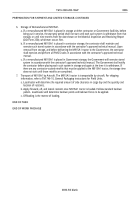TM-9-2320-283-13-P - Page 267 of 400
TM 9-2320-283-13&P
0037
0037-3/4 blank
GENERAL INSPECTION PROCEDURES
Procedures for inspections are the same for many parts and components that make up vehicle subassemblies.
Dimensional standards for parts have been fixed at extremely close tolerances, so use specification tables located
throughout this manual. Use specified inspection equipment for inspections where cracks and other damage
cannot be seen. Exercise extreme care in all phases of inspection and adhere to the following guidelines:
1.
When inspecting castings perform the following inspections:
a. Inspect all ferrous and non-ferrous castings for cracks using a magnifying glass and a strong light.
b. Check areas around studs, pipe plugs, threaded inserts, and sharp corners for cracks. Replace all
cracked castings.
c. Inspect machined surfaces for nicks, burrs, or raised metals. Mark damaged areas for repair or
replacement.
d. Inspect all pipe plugs, pipe plug openings, screws, and screw openings for damaged or stripped
threads.
e. Using straight edge or surface place, check all gasket mating surfaces, flanges on housings, and
supports for warpage. Visually inspect mating flanges for discolorations. This may indicate persistent
oil leakage.
f. Check all castings for conformance to applicable repair standards.
2.
Refer to TM 9-214 for inspection of bearings. Check all bearings for conformance to applicable repair
standards.
3.
Replace studs, bolts, and screws if threads are damaged, bent, loose, or stretched.
4.
Using magnifying glass and strong light, inspect all gears for cracks. No cracks are allowed. Inspect gear
teeth for wear, sharp fins, burrs, and galled or pitted surfaces. Check keyway slots for wear and/or
damage.
5.
Check all bushings and bushing-type bearings for secure fit, evidence of overheating, wear, burrs, nicks,
and out-of-round condition. Check for dirt in lubrication holes or grooves. Holes and grooves must be
clean and free from damage.
6.
All seals must be replaced with new seals.
7.
Inspect core hole expansion plugs for leakage. Replace plugs when leakage is present.
8.
Inspect machined-tooled parts for cracks, breaks, elongated holes, wear, and chips.
9.
Inspect machined surfaces for cracks, evidence of wear, burrs, nicks, pitted surfaces, and scratches.
10.
Inspect mated surfaces for remains of old gaskets or seals, evidence of leakage, pitting, and secure fit.
11.
Inspect surfaces for rust, pitting, holes, and severe damage.
12.
Inspect oil bathed internal parts for cracks, nicks, burrs, evidence of overheating, and wear.
13.
Inspect air actuated internal parts for cracks, nicks, burrs, evidence of overheating, and wear.
14.
Inspect externally exposed parts for breaks, cracks, rust damage, and wear.
15.
Inspect springs for broken, collapsed, and twisted coils.
16.
Inspect batteries for damage, cracks, leaks, corrosion, and broken or loose terminals.
17.
Inspect battery cables for damage and corrosion. For general cleaning instructions, maintenance, and
servicing of battery cables and clamps, refer to TM 9-6140-200-13.
END OF TASK
END OF WORK PACKAGE
Back to Top




















